Menu
Physics Lesson 16.15.4 - Resistive, Inductive and Capacitive Load
Please provide a rating, it takes seconds and helps us to keep this resource free for all to use
Welcome to our Physics lesson on Resistive, Inductive and Capacitive Load, this is the fourth lesson of our suite of physics lessons covering the topic of Introduction to RLC Circuits, you can find links to the other lessons within this tutorial and access additional physics learning resources below this lesson.
Resistive, Inductive and Capacitive Load
To make the understanding of a RLC circuit more digestible, we will discuss separately three simple circuits, each of them containing only an external emf and one of the three circuit components: resistor, capacitor or inductor, which produce a load in the circuit. Let's start with the circuit that produces the resistive load.
a) Resistive Load
Let's consider a circuit containing only an alternating emf source and a resistor as shown in the figure.
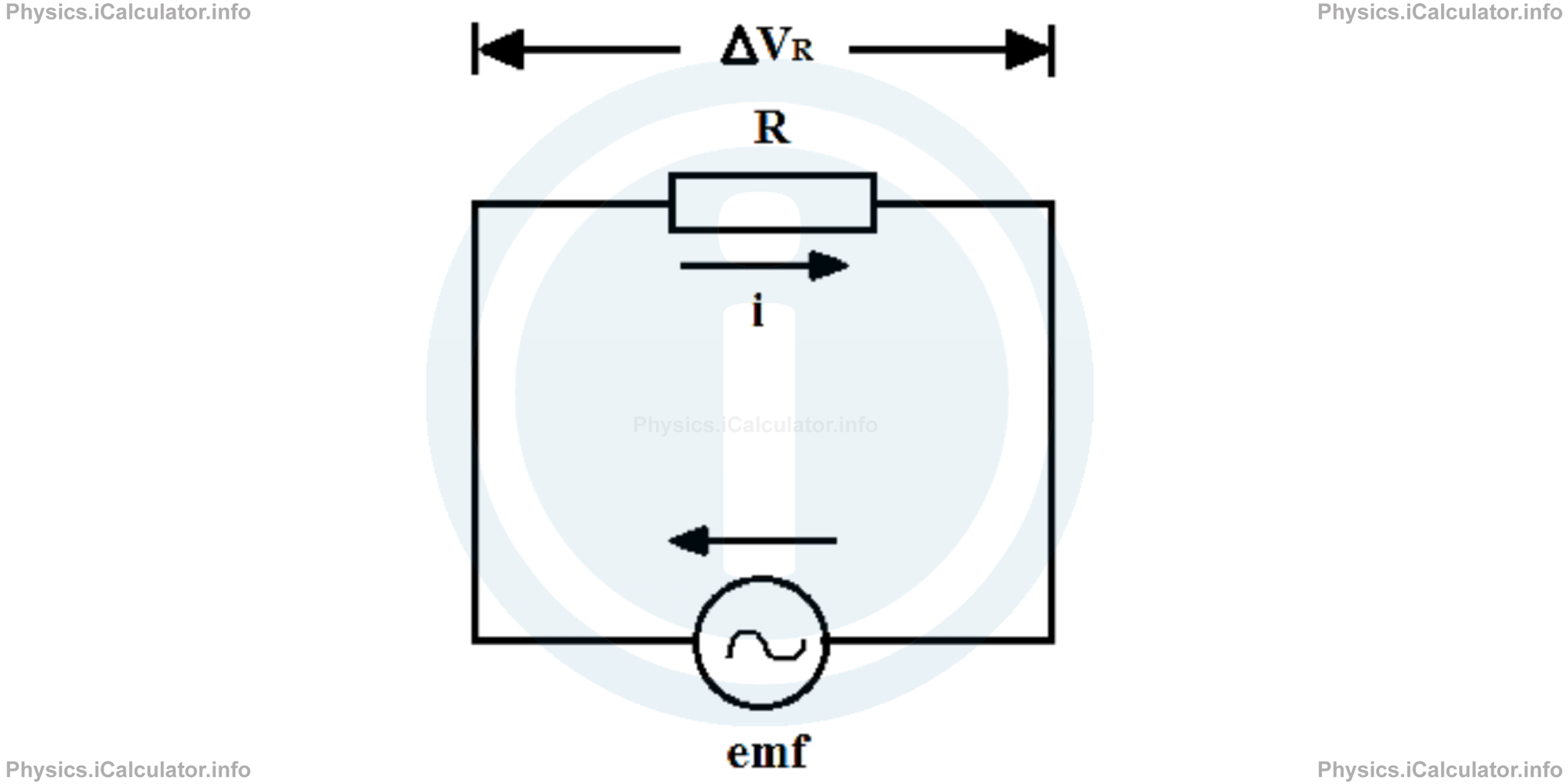
From the Law of Energy Conservation, we have
where ΔVR is the potential difference across the resistor. We can write this equation as
When neglecting the resistance of conducting wire, we obtain
Moreover, we have for the current in the circuit:
Giving that in this type of circuit the current is in phase with the potential difference, we have φ = 0. The graph below shows one cycle of induced current and potential difference in an AC circuit containing a resistive load:
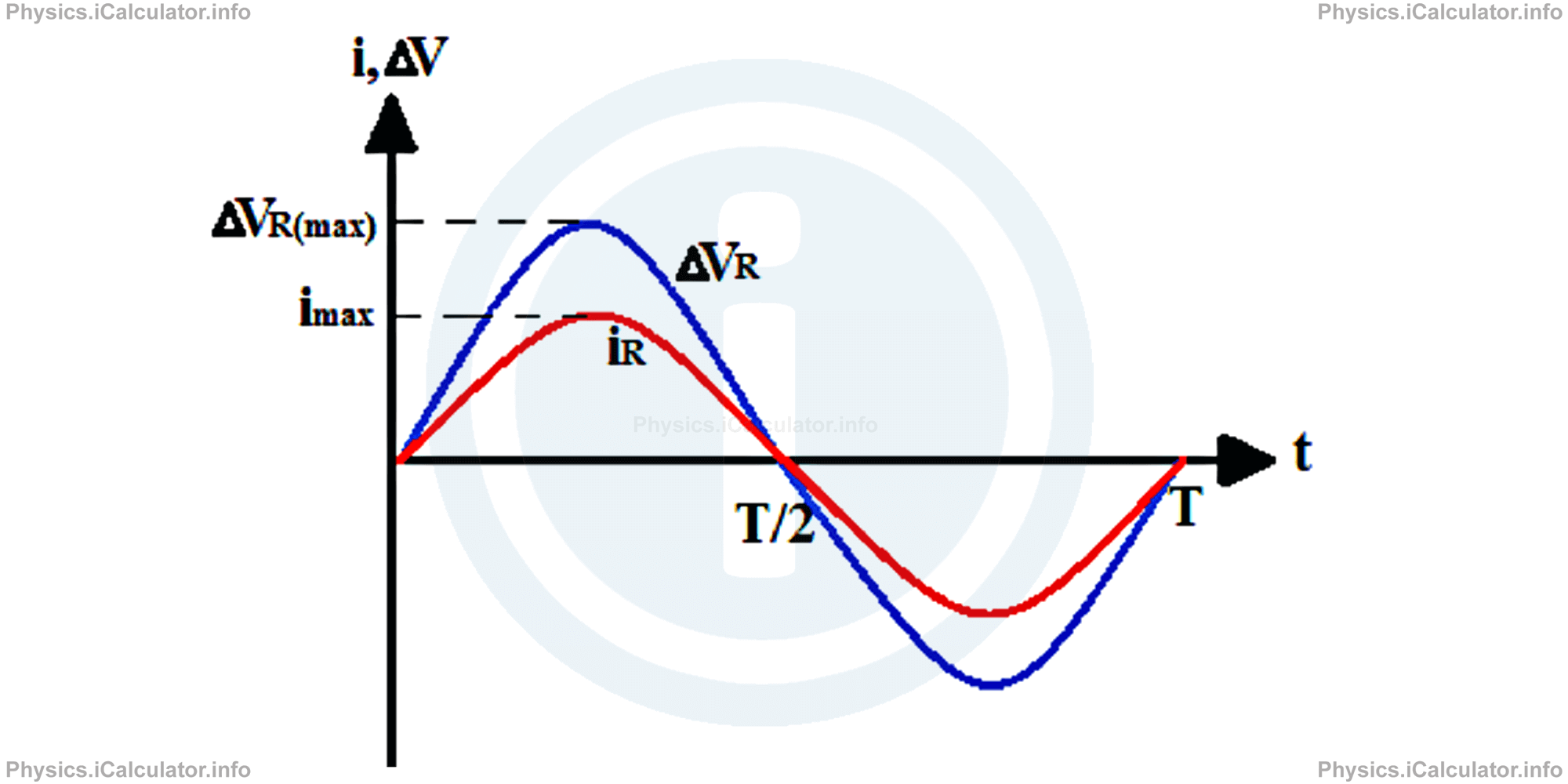
To make the graph plotting easier, we use arrows similar to vectors even though neither current nor voltage are vectors. These diagrams are known as phasor diagrams. The angle formed by the arrows and the horizontal (time) axis gives the ωt term. A phasor diagram pertaining the above graph is shown below:
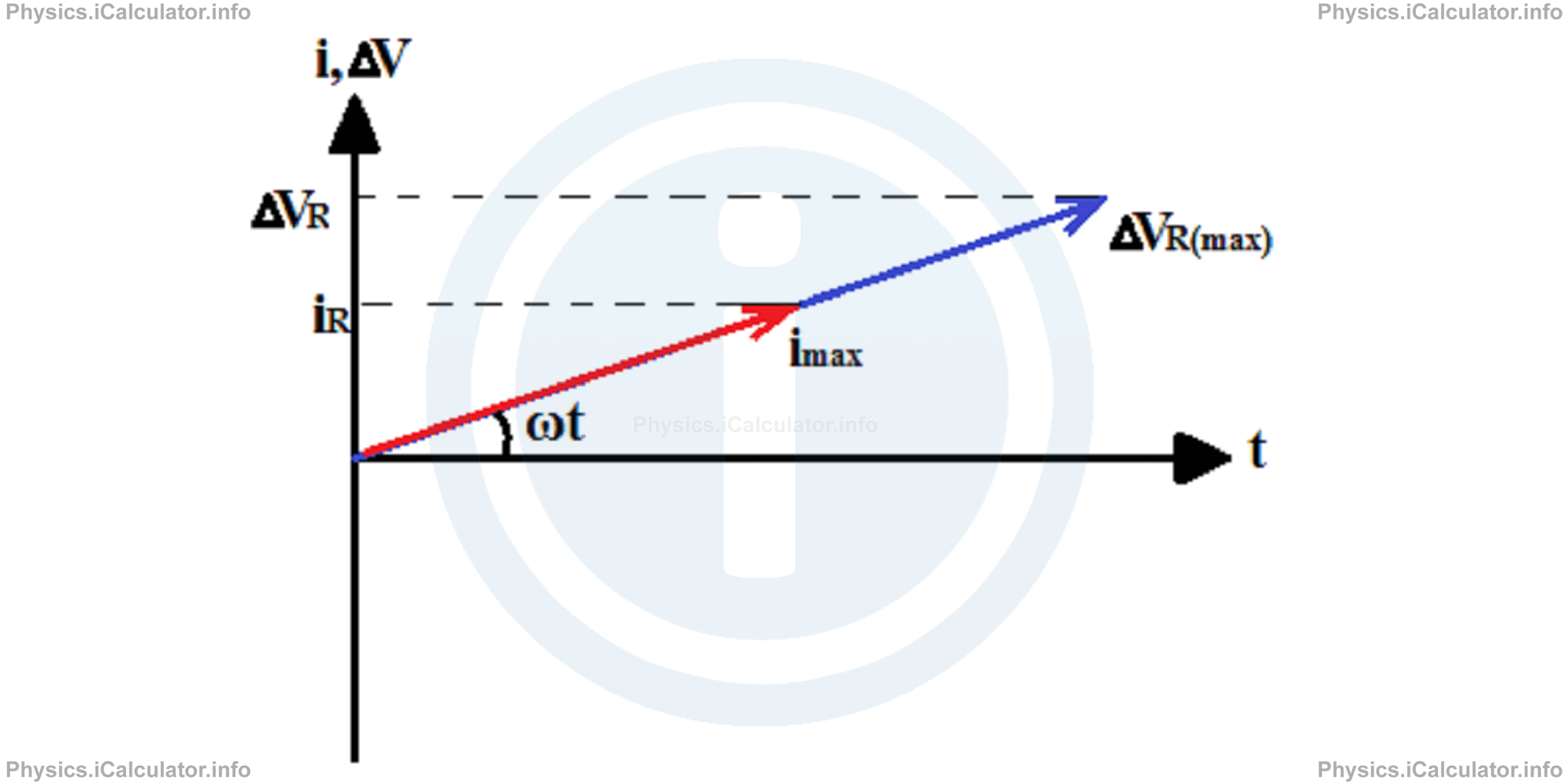
Example 3
The voltage of an AC generator is given by the equation ΔV(t) = 90 sin ωt and the frequency of generator is 60 Hz. Calculate:
- The maximum current produced by the generator if it is connected to a 30 Ω resistor
- The potential difference in the circuit at t = 2.504 s.
Solution 3
- From the equation of voltage, we notice than the maximum voltage (potential difference) in the circuit is 90 V. In addition, we obtain for the maximum current flowing through the circuit: imax = ∆Vmax/R
= 90 V/30 Ω
= 3A - The potential difference at t = 2.504 s (giving that ω = 2πf and f = 60 Hz), is ΔV(2.504) = 90 ∙ sin (2π ∙ 60 ∙ 2.504)
= 90 ∙ sin (2π ∙ 60 ∙ 2.504)
= 90 ∙ sin 300.48π
= 90 ∙ sin 0.48π
= 90V ∙ 0.998
= 89.82 V
b) Capacitive Load
Now, let's consider a circuit supplied by an AC source, which contains only a capacitor C as shown in the figure.
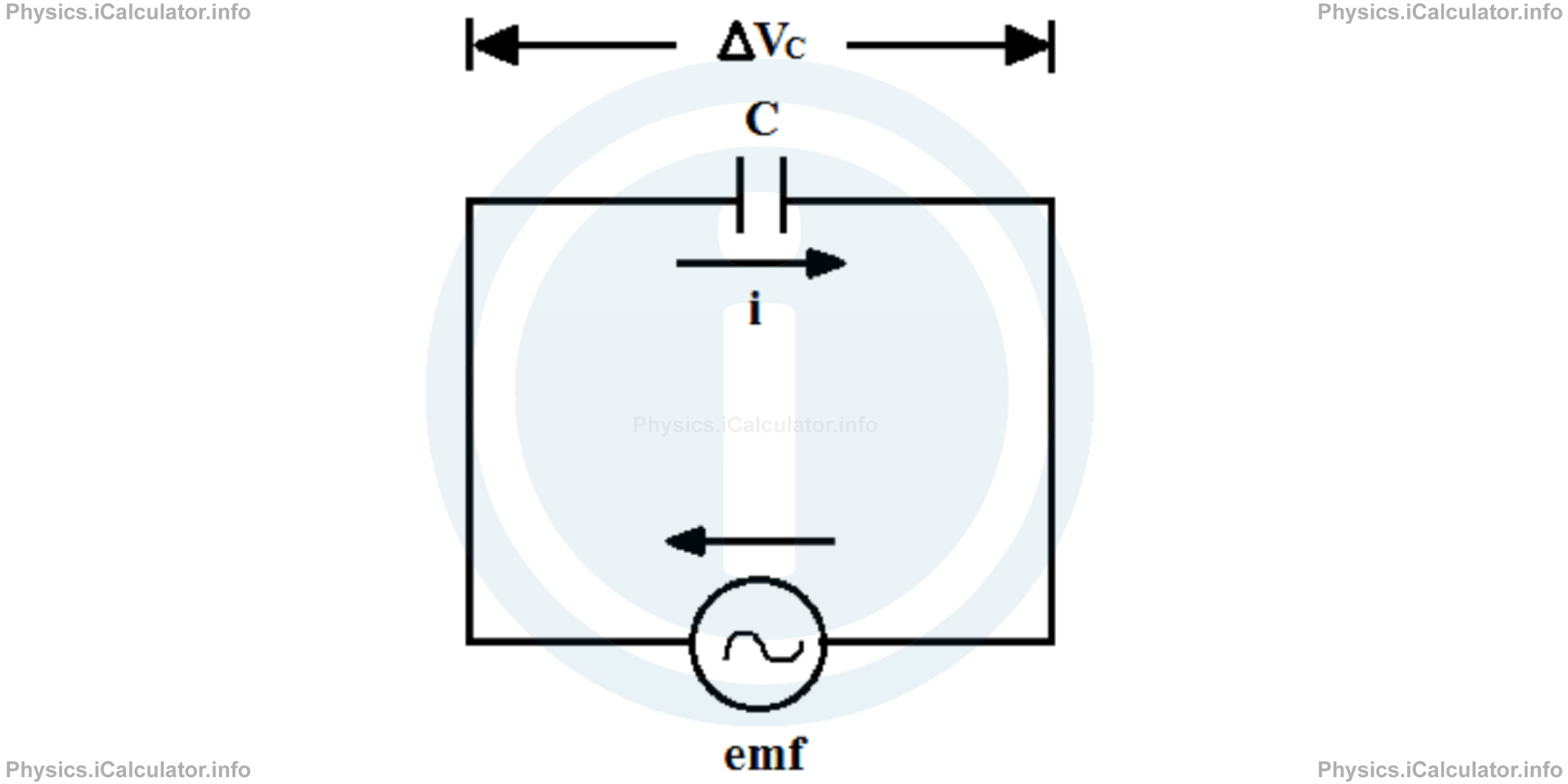
Using a similar approach as we did when dealing with the resistive load, we obtain for the potential difference at any instant across the capacitor:
From the definition of capacitance, we have for the charge stored in the capacitor at any instant t:
= C ∙ ∆VC(max) ∙ sin ωd ∙ t
and for the current at any instant t:
The quantity
is called capacitive reactance of capacitor. It has the unit of resistance (Ohm).
From experiments, it results that current leads by one quarter of a cycle the voltage in such a circuit. If we replace the cos ωd ∙ t term with a phase-shifted sine expression of + π/2 rad, we obtain
Hence, we obtain for the current in the circuit:
In addition, we have for the maximum potential difference in the circuit
Since there is a shift in phase by one quarter of a period (π/2 = 2π/4 = T/4), the graphs of potential difference and current versus time for one complete cycle are:
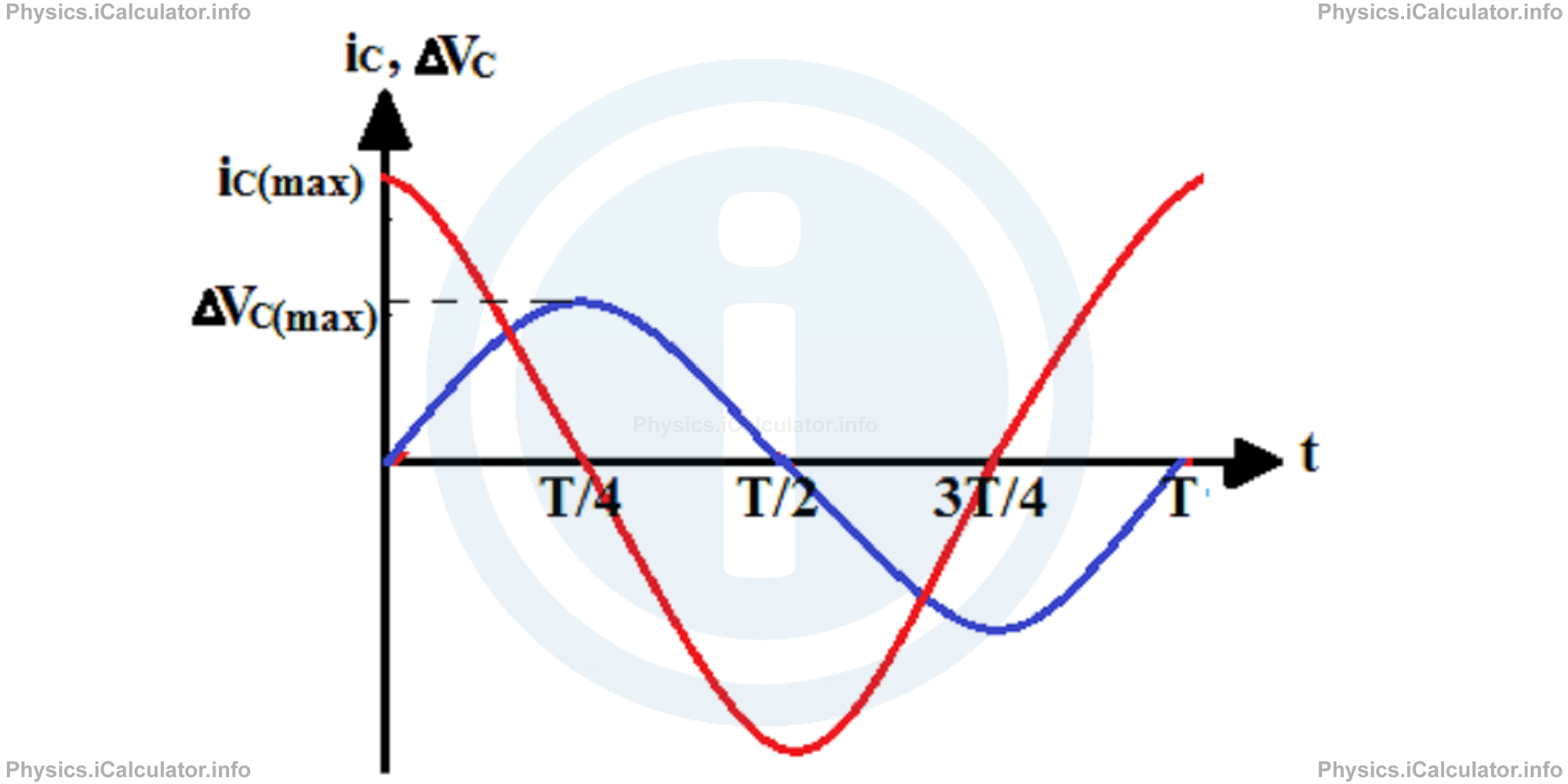
The corresponding phasor diagram for this circuit is 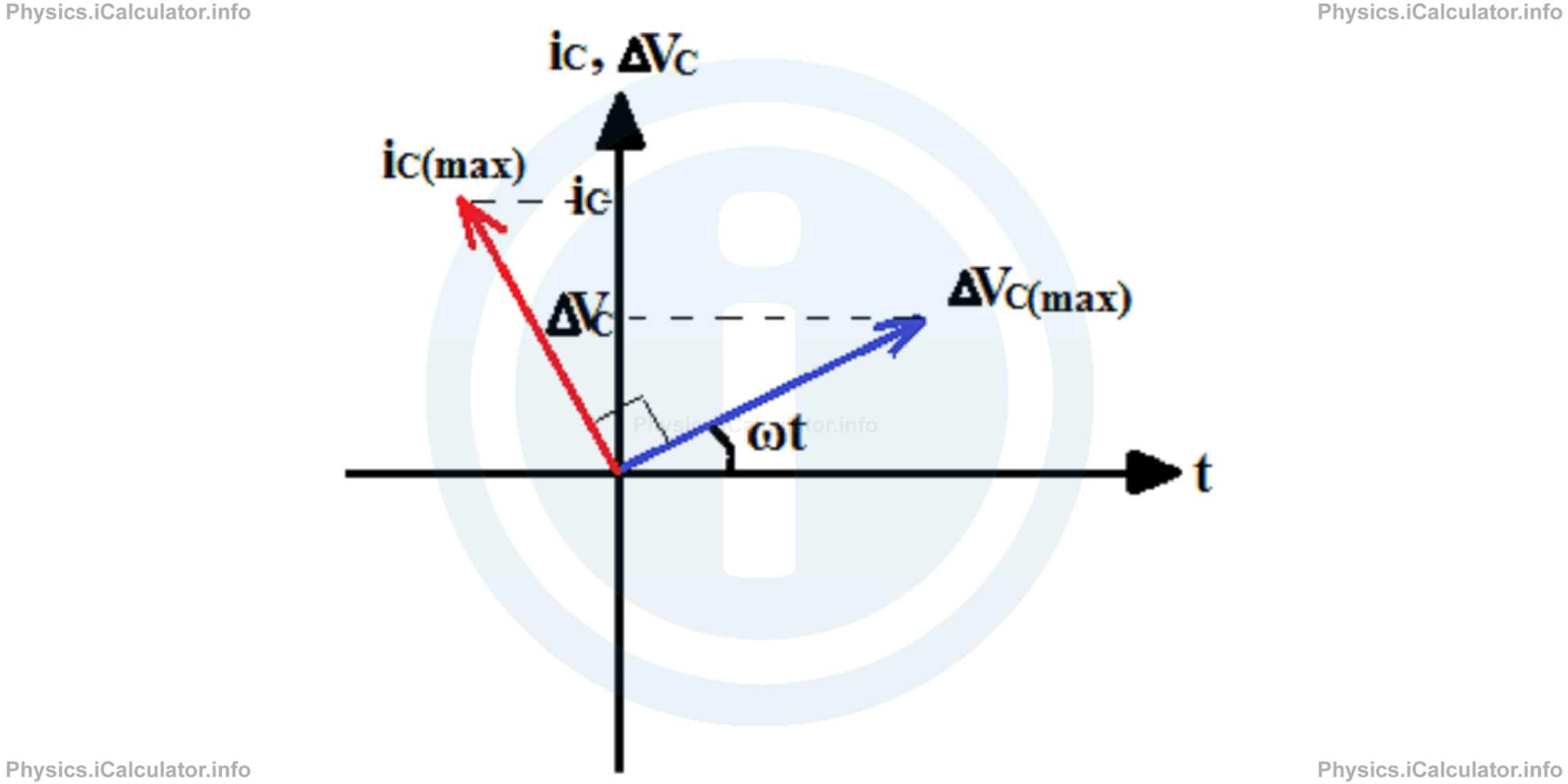
The current is π/2 (a quarter of a cycle) in advantage to potential difference. Therefore, we say: "the current leads the voltage by π/2".
Remark! The capacitive reactance behaves as an AC resistance. As the frequency of current approaches zero, the capacitive reactance raises to infinity and as a result, the circuit behaves as a DC circuit. However, the current flow in this way (in one direction only) is prevented from the high resistance between the plates of capacitor (at the gap between the plates), which does not allow the current to flow between the plates and to close therefore the cycle.
Example 4
A circuit containing a 60 Hz AC power source that oscillates according the equation ΔVC(t) = 50 ∙ sin ωd ∙ t and a 20 μF capacitor as shown in the figure.
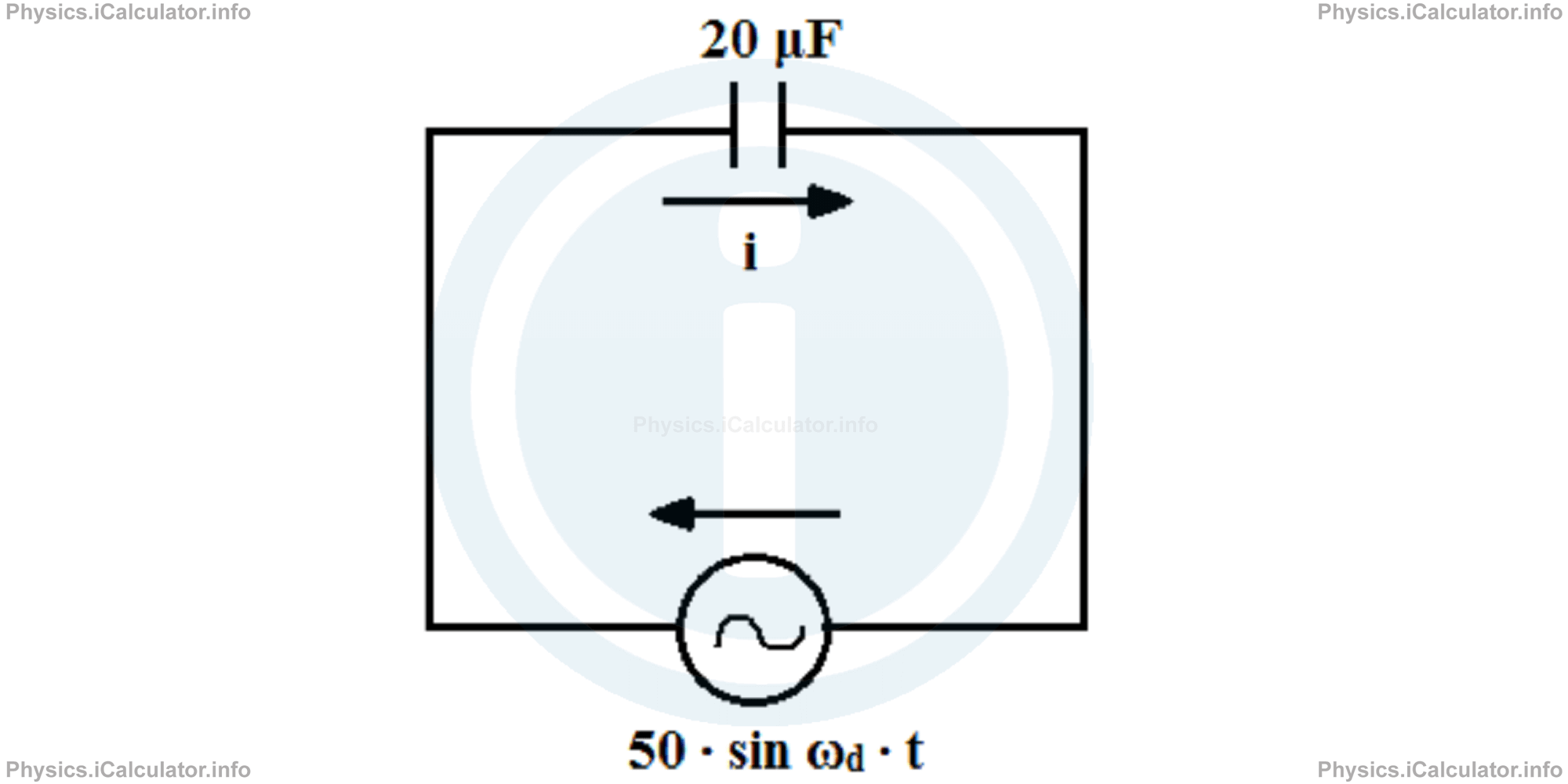
Calculate:
- The capacitive reactance in the circuit
- The maximum current flowing in the circuit
- The value of voltage and current in the circuit at t = 1.406 s.
Solution 4
- From the clues, it is clear that ΔVC(max) = 50 V, C = 20μF = 2 × 10-5 F and f = 60 Hz. Thus, for capacitive reactance, we have Xc = 1/ωd ∙ C
= 1/2π ∙ f ∙ C
= 1/2 ∙ 3.14 ∙ (60 Hz) ∙ (2 × 10-5 F)
= 132.7Ω - The maximum current flowing through the circuit is given by ∆VC(max) = iC(max) ∙ XcThus,ic(max) = ∆Vc(max)/Xc
= 50 V/132.7Ω
= 0.38 A - The value of voltage in the circuit at t = 1.406 s is ∆Vc (t) = ∆VC(max) ∙ sin ωd ∙ tAs for the current at t = 1.406 s, we have
∆Vc (1.406) = 50 ∙ sin (2π ∙ 60 ∙ 1.406)
= 50 ∙ sin (168.72π)
= 50 ∙ sin (0.72π)
= 50V ∙ 0.77
= 38.5 Vic (t) = iC(max) ∙ sin (ωd ∙ t + π/2)The negative sign shows direction; it means the current actually is flowing in the opposite direction to the initial current at t = 0.
ic (1.406) = 0.38 ∙ sin (168.72π + π/2)
= 0.38 ∙ sin (169.22π)
= 0.38 ∙ sin (1.22π)
= 0.38A ∙ (-0.64)
= -0.24 A
c) Inductive Load
The reasoning is the same even when we have a circuit in which there is only an AC source and an inductor as shown in the figure.
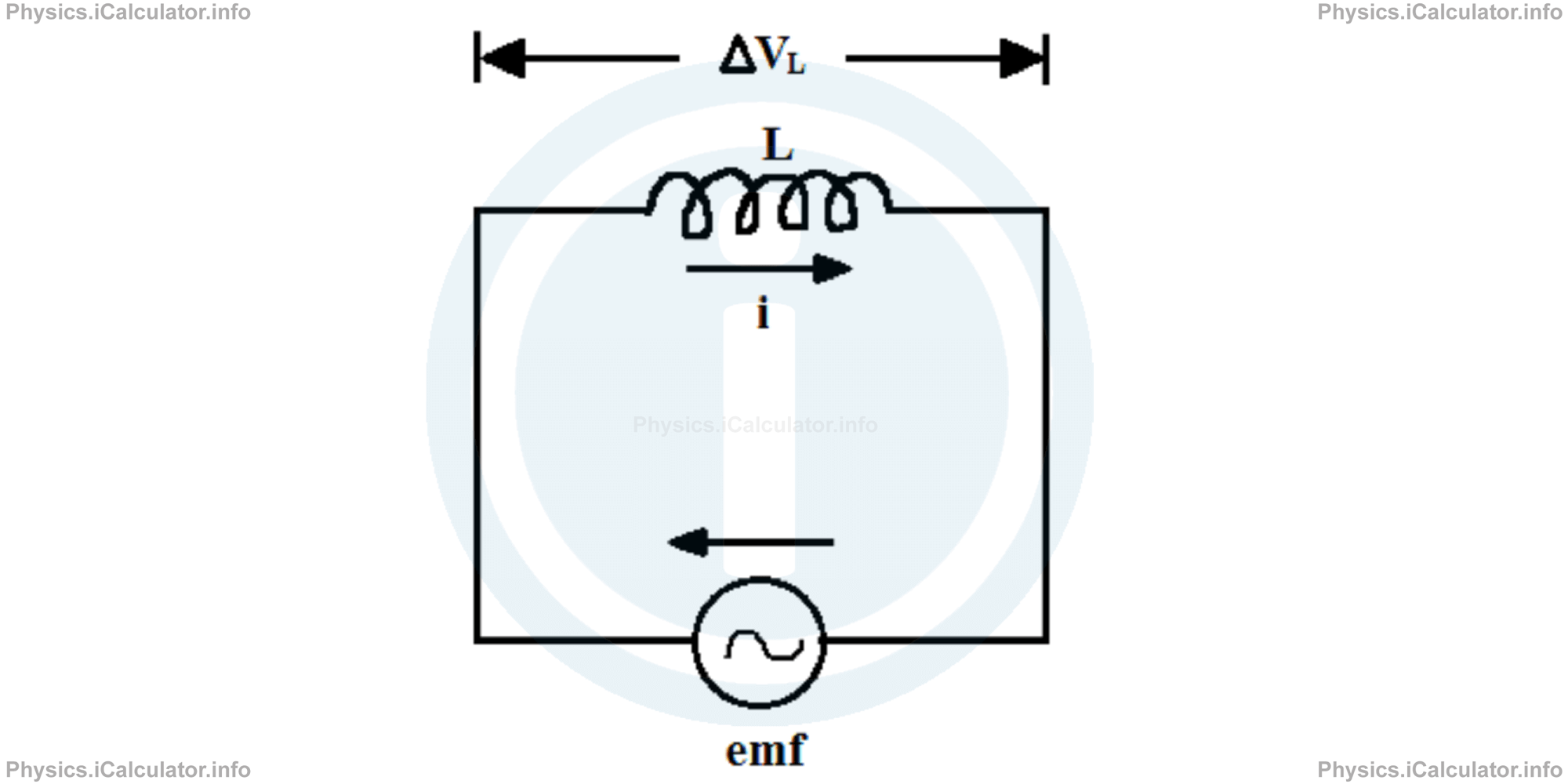
The potential difference across the inductor is
From Faraday's Law, we have
Thus, combining the above equations, we obtain
Or
The current flowing at any instant in the circuit is obtained through integration techniques. Thus,
= ∆VL(max)/L ∙ (-1/ωd ) ∙ cos(ωd ∙ t)
= -∆VL(max)/ωd ∙ L ∙ cos(ωd ∙ t)
The quantity
is called inductive reactance and is measured in Ohms, similarly to capacitive reactance discussed in the previous paragraph.
Using the trigonometric identity
we obtain for the current flowing in a circuit containing an inductive load:
From this equation, we can see that for a purely inductive load, the current is delayed (is out of phase) by π/2 (a quarter of a cycle) to the potential difference. Therefore, we obtain the graph below:
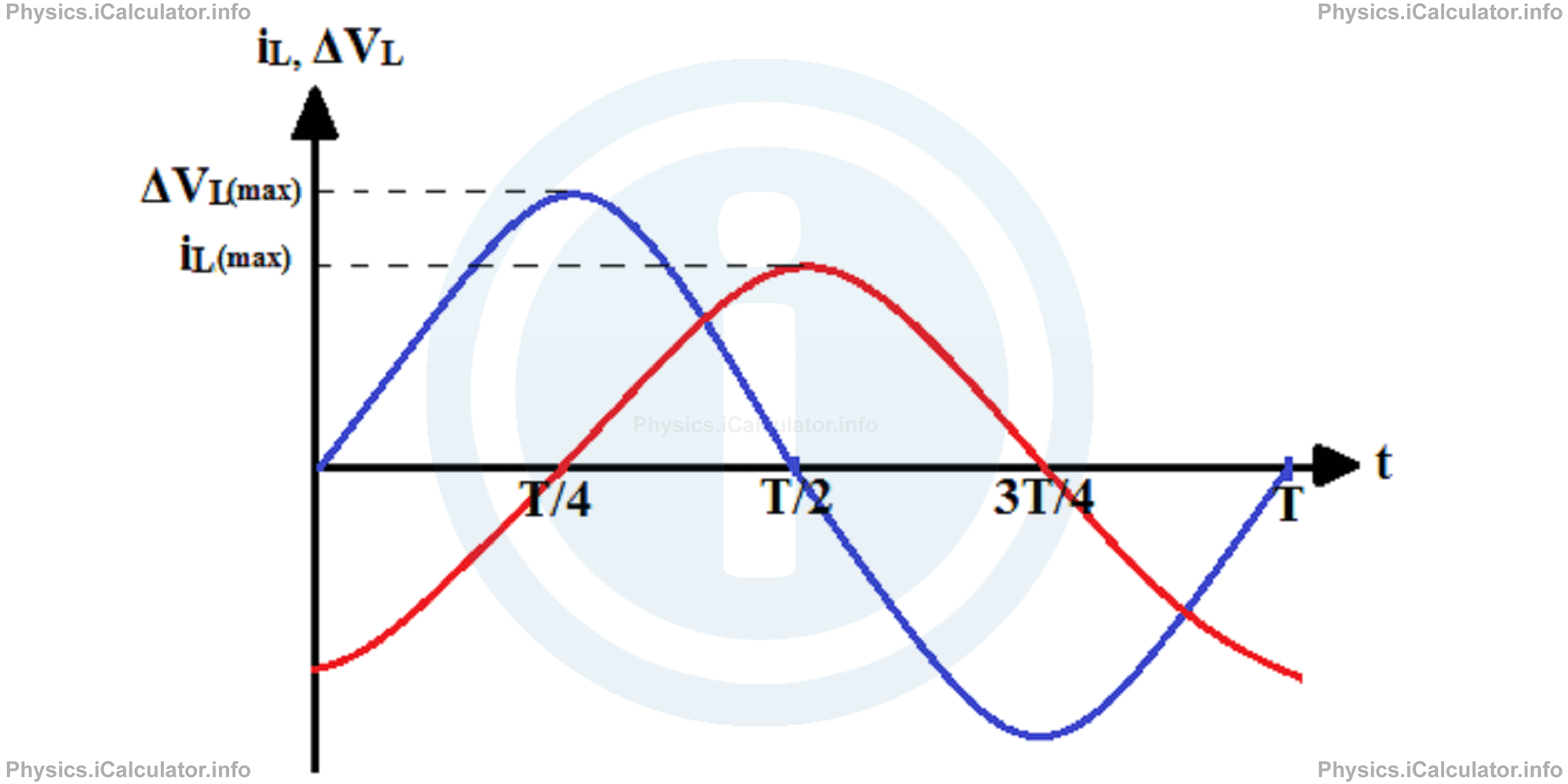
Again, we use the phasor concept to simplify the understanding of the above graph. The phasor diagram that corresponds the above graph is shown below:
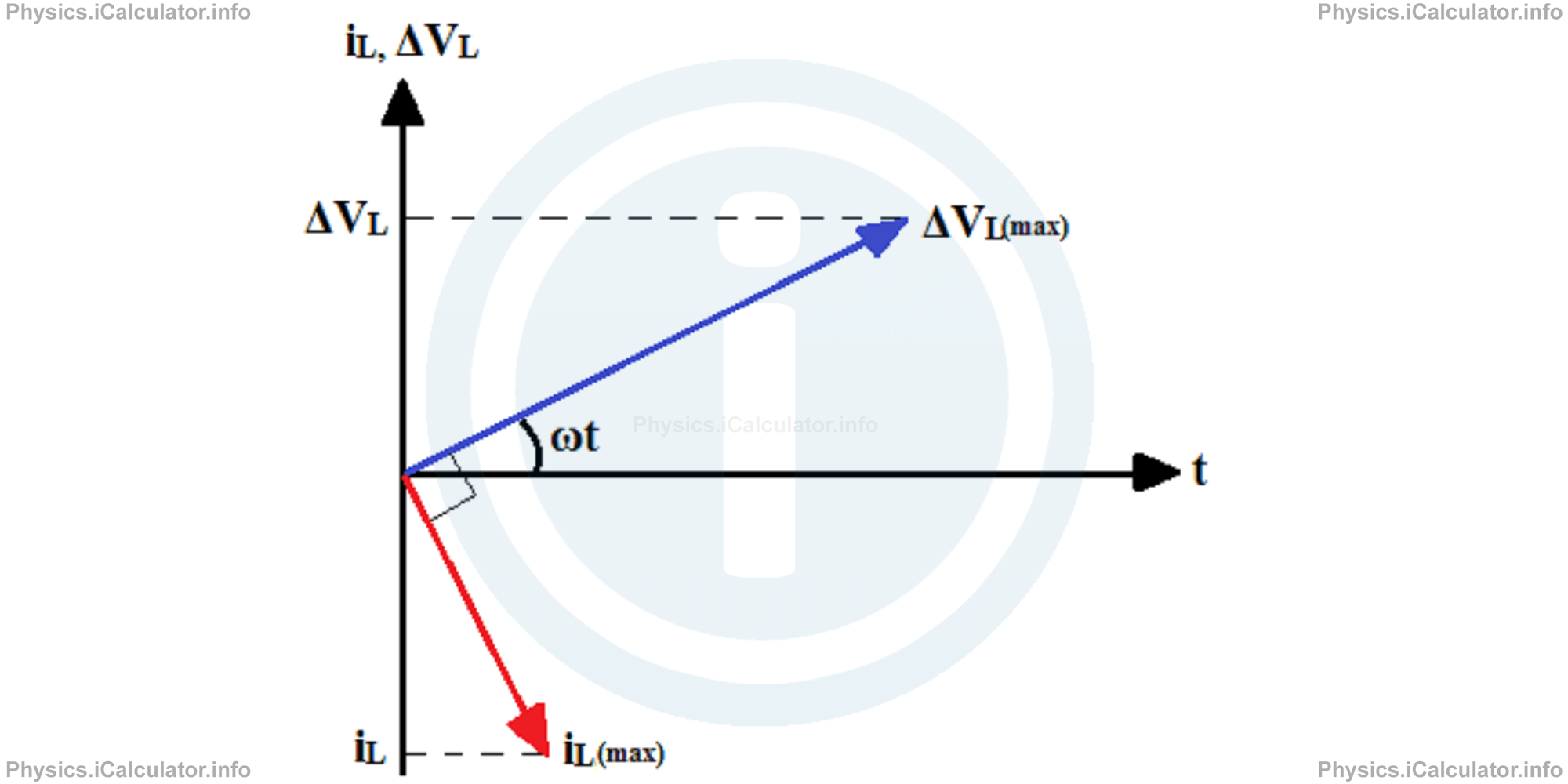
Example 5
A 0.2 H inductor is connected to an AC source of voltage ΔVC(t) = 40 ∙ sin(100 π ∙ t).
- Calculate the inductive reactance of the circuit
- Write the equation of current in the circuit as a function of time
- Calculate the current and voltage in the circuit at t = 4.961 s.
Solution 5
- From the clues, we have ΔVL(max) = 40 V and L = 0.2 H. In addition, we have ωd = 2πf = 100πso, f = 50 Hz. The inductive reactance in the circuit isXL = ωd ∙ L
= 100π ∙ 0.2
= 20π Ω
= 20 ∙ 3.14 Ω
= 62.8 Ω - Since the inductive reactance is like a resistance in the circuit, we obtain for the maximum current flowing through the circuit (applying the Ohm's Law): iL(max) = ΔVL(max)/XLTherefore, the equation of current in the circuit is
= 40V/62.8Ω
= 0.64AiL (t) = ∆VL(max)/ωd ∙ L ∙ sin(ωd ∙ t - π/2)
= 40/100π ∙ 0.2 ∙ sin (100π ∙ t - π/2)
= - 2/π ∙ sin (100π ∙ t - π/2)
= 0.64 ∙ sin (100π ∙ t - π/2) - The current at t = 4.961s is iL (4.961) = 0.64 ∙ sin (100π ∙ 4.961 - π/2)and the voltage in the circuit at t = 4.961s is
= 0.64 ∙ sin (100π ∙ 4.961 - π/2)
= 0.64 ∙ sin (496.1π - π/2)
= 0.64 ∙ sin (495.6π)
= 0.64 ∙ sin (1.6π)
= 0.64A ∙ (-0.95)
= 0.61A∆VL (t) = ∆VL(max) ∙ sin(ωd ∙ t)
∆VL (4.961) = ∆VL(max) ∙ sin(ωd ∙ t)
= 40 ∙ sin(100π ∙ 4.961)
= 40 ∙ sin(496.1π)
= 40 ∙ sin(0.1π)
= 40V ∙ 0.31
= 12.4V
You have reached the end of Physics lesson 16.15.4 Resistive, Inductive and Capacitive Load. There are 4 lessons in this physics tutorial covering Introduction to RLC Circuits, you can access all the lessons from this tutorial below.
More Introduction to RLC Circuits Lessons and Learning Resources
Whats next?
Enjoy the "Resistive, Inductive and Capacitive Load" physics lesson? People who liked the "Introduction to RLC Circuits lesson found the following resources useful:
- Resistance Feedback. Helps other - Leave a rating for this resistance (see below)
- Magnetism Physics tutorial: Introduction to RLC Circuits. Read the Introduction to RLC Circuits physics tutorial and build your physics knowledge of Magnetism
- Magnetism Revision Notes: Introduction to RLC Circuits. Print the notes so you can revise the key points covered in the physics tutorial for Introduction to RLC Circuits
- Magnetism Practice Questions: Introduction to RLC Circuits. Test and improve your knowledge of Introduction to RLC Circuits with example questins and answers
- Check your calculations for Magnetism questions with our excellent Magnetism calculators which contain full equations and calculations clearly displayed line by line. See the Magnetism Calculators by iCalculator™ below.
- Continuing learning magnetism - read our next physics tutorial: The Series RLC Circuit
Help others Learning Physics just like you
Please provide a rating, it takes seconds and helps us to keep this resource free for all to use
We hope you found this Physics lesson "Introduction to RLC Circuits" useful. If you did it would be great if you could spare the time to rate this physics lesson (simply click on the number of stars that match your assessment of this physics learning aide) and/or share on social media, this helps us identify popular tutorials and calculators and expand our free learning resources to support our users around the world have free access to expand their knowledge of physics and other disciplines.
Magnetism Calculators by iCalculator™
- Angular Frequency Of Oscillations In Rlc Circuit Calculator
- Calculating Magnetic Field Using The Amperes Law
- Capacitive Reactance Calculator
- Current In A Rl Circuit Calculator
- Displacement Current Calculator
- Electric Charge Stored In The Capacitor Of A Rlc Circuit In Damped Oscillations Calculator
- Electric Power In A Ac Circuit Calculator
- Energy Decay As A Function Of Time In Damped Oscillations Calculator
- Energy Density Of Magnetic Field Calculator
- Energy In A Lc Circuit Calculator
- Faradays Law Calculator
- Frequency Of Oscillations In A Lc Circuit Calculator
- Impedance Calculator
- Induced Emf As A Motional Emf Calculator
- Inductive Reactance Calculator
- Lorentz Force Calculator
- Magnetic Dipole Moment Calculator
- Magnetic Field At Centre Of A Current Carrying Loop Calculator
- Magnetic Field In Terms Of Electric Field Change Calculator
- Magnetic Field Inside A Long Stretched Current Carrying Wire Calculator
- Magnetic Field Inside A Solenoid Calculator
- Magnetic Field Inside A Toroid Calculator
- Magnetic Field Produced Around A Long Current Carrying Wire
- Magnetic Flux Calculator
- Magnetic Force Acting On A Moving Charge Inside A Uniform Magnetic Field Calculator
- Magnetic Force Between Two Parallel Current Carrying Wires Calculator
- Magnetic Potential Energy Stored In An Inductor Calculator
- Output Current In A Transformer Calculator
- Phase Constant In A Rlc Circuit Calculator
- Power Factor In A Rlc Circuit Calculator
- Power Induced On A Metal Bar Moving Inside A Magnetic Field Due To An Applied Force Calculator
- Radius Of Trajectory And Period Of A Charge Moving Inside A Uniform Magnetic Field Calculator
- Self Induced Emf Calculator
- Self Inductance Calculator
- Torque Produced By A Rectangular Coil Inside A Uniform Magnetic Field Calculator
- Work Done On A Magnetic Dipole Calculator